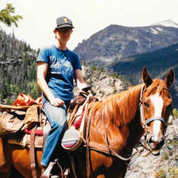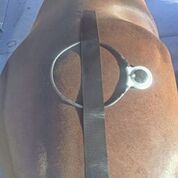 Dr. Cynthia Reynolds, who is based in Searsport, Maine, is well-versed in integrative healing methods such as chiropractic and acupuncture, and she believed the Assisi Loop’s targeted pulsed electromagnetic field therapy (tPEMF™) would be helpful for Dell, a horse with navicular disease.
Dr. Cynthia Reynolds, who is based in Searsport, Maine, is well-versed in integrative healing methods such as chiropractic and acupuncture, and she believed the Assisi Loop’s targeted pulsed electromagnetic field therapy (tPEMF™) would be helpful for Dell, a horse with navicular disease.
Dell was “definitely lame,” Dr. Reynolds says. “It was severe foot pain. They couldn’t ride the horse. They actually thought they were going to have to retire the horse completely.”
When the Healeys began using the Loop on Dell, however, “after she used it one or two days she could see a big difference,” Dr. Reynolds says. “The fluid had dissipated.” Another one of the Healeys’ horses had an injured knee for which Dr. Reynolds also recommended PEMF treatment for horses. The horse “had an old injury on the right knee. Every time I would check the horse it would be just slightly tender on flexion. We never could get anything to work on that. [Celeste] used to ice these horses constantly, and she’s tried other things which did not make them sound. But now she’s been Looping that knee as well, and she can flex that knee. The horse kicks that knee up perfectly now.”
And Dr. Reynolds says of Dell, “the one they were going to retire–they’re back in full training for that horse now, and expecting to go farther than they had a few years ago. It’s been a big improvement in both these horses.”
Dr. Reynolds recommends the Loop for “anything that’s got inflammation in it, especially post-surgical. I think the sooner you get it on, the better. I would recommend using it on any initial injury.” And, in closing: “I just think they’re great. It’s been a really good product for my clients to be using.”
 Dr. Glenn Healey and his wife, Celeste Healey, love everything about their horses. Their animals’ champion dressage scores and national competition records say a lot for the couple’s dedication, training, and drive, but even more than the horses’ success, they love the horses themselves. When their horses win, it’s a thrill–but even if they stopped competing tomorrow, it’s safe to say that the Healeys would still be in love with their animals.
Dr. Glenn Healey and his wife, Celeste Healey, love everything about their horses. Their animals’ champion dressage scores and national competition records say a lot for the couple’s dedication, training, and drive, but even more than the horses’ success, they love the horses themselves. When their horses win, it’s a thrill–but even if they stopped competing tomorrow, it’s safe to say that the Healeys would still be in love with their animals.
Dr. Healey explains that dressage horses, unlike other competition disciplines, are typically in their prime when they’re older. A champion racehorse will retire by 6; a barrel racer will certainly be done by 12; but a great dressage horse doesn’t usually come into his own until age 12, and competing dressage horses often are at least around age 14-18. As a result, the Healeys’ competition horses are aging, and the couple wants to stay on top of treatments for the inflammatory ailments that often come with age.
So when, in 2014, one of their competition horses, Dell, started showing severe pain in his right front
hoof and stifle originating from navicular disease, Celeste and Dr. Healey were willing to do anything to get him feeling better. It looked like his dressage career was over. If he could compete again, that would be an added bonus, but it wasn’t the end goal.
“I mean, we’ve tried everything for this horse,” Celeste recalls. “Absolutely everything… I tried bute [phenylbutazone], I tried everything, and nothing would really make him sound. … I didn’t even want to ride him. It was awful.” One of the Healeys’ vets, Dr. Cynthia Reynolds, focuses on acupuncture, chiropractic work, and homeopathic remedies, and they were trying these more gentle methods for Dell’s recovery. The bute gave him gastrointestinal upset and didn’t work well enough for him to justify that discomfort.
“At one point I had his feet in buckets of ice because he was so sore, and he’d lay down. He didn’t want to get up,” Celeste says. “I thought he was dead at one point. His eyes were rolled back white, he was in so much pain. It’s the kind of thing where you think, ‘Maybe I should put the horse down.’ It was horrible.”
Even beyond the results, the scientific part of Dr. Healey’s brain took great stock in the Loop’s ability to catalyze the nitric oxide cycle. “That was, for me, an important thing to get me to even try the Loop. There was good, fundamental, the basic science behind what we were believing was working.” After calling Assisi’s customer service and making sure it was okay to do so, Celeste even upped Dell’s treatments to more than four times per day, to get as much benefit as possible.
An accidental “control experiment” popped up during Dell’s treatment, however, when Celeste went away for the weekend. While she was gone, Dell only received about half the treatments he should have been getting, and there was a noticeable difference in his soundness when she returned. She resumed four treatments per day and soon Dell was once again sound.
“In dressage, it’s all about the older horses,” Dr. Healey says. “That’s going to be a great market for this, because that’s when they’re all falling apart.” It’s a huge benefit to be able to “keep that very expensive horse going for another year before they have to retire him. That would be fabulous in terms of the savings, because this is a trained horse.”
After seeing the benefits of the Loop on Dell, Dr. Healey and Celeste used the Loop on other inflammatory issues in their menagerie. Their elderly dog had advanced arthritis, and Celeste used the Loop three times a day on his knee. “He hadn’t trotted for about a year, he only walked. I put those Loops on him and he trotted off the next day.”
Another horse got a scratch on her eye, and Celeste taped the Loop right to her head and treated the pain. “She couldn’t open her eye and I used [the Loop],” she says. “And she opened her eye. I put it on every night for probably a week. And that eye was really bad. I mean, I called the vet, and they had to come out and they gave me some medicine, but what helped for her with the pain was the Loop.”
Celeste recalls that Dr. Reynolds came to her with a new treatment option: the Assisi Loop. Celeste, willing to try just about anything, was also on board to practice full compliance with multiple treatments per day on Dell’s extremely inflamed leg.
“The very first time I used it, I got on the horse and I could tell there was a difference,” Celeste says. “After one treatment.” She began using it four times per day–at morning feed, before working, after working, and at evening feed. The results, she says, were nothing short of astounding.
“I know this horse so well that when I lead him out of his stall I can tell by the way he walks how his feet feel. I know if they hurt,” she says. “I could tell his feet didn’t hurt as much. And then it took a little time, and [the pain] was all gone.” She references having gotten Dell’s hooves “nerved” as a last resort, a neurectomy surgery in which the inflamed nerve is altogether removed. “His nerves grew back, and within six months and he was lame again,” she says. “It just didn’t work. And this Loop is what worked. It’s the only thing that worked.”

Dr. Healey, who is a radiation oncologist with experience in treating breast cancer patients, was eager to assess the clinical trials done on targeted pulsed electromagnetic field therapy (tPEMF), which the Loop employs. Dr. Reynolds had given the Healeys a collection of peer-reviewed studies and articles about tPEMF, and Dr. Healey says, “I read most of the articles, but the one that stood out was the post-mastectomy trial. The big difficulty I have in trying to do subjective assessments–‘Is my horse getting better anyway, or is he getting better because of the Loop?’–really is dispelled when you look back at the basic literature because patients who have less pain and are taking fewer narcotics. That just doesn’t lie. It was a very powerful clinical message.”
Dr. Healey also tells the story of his 18-year-old horse, Sampson. “In fall 2014, he had a serious avulsion of a tendon in his right stifle. He was three-legged lame. He couldn’t even put weight on it,” Dr. Healey says. Sampson had two surgeries to correct the damage done in his stifle, and, Dr. Healey says, “in the rehab period, because we had already seen the results with Dell, we started using the Loop on his stifle. And Sampson rehabbed quicker than I think he would have otherwise.”

However, Sampson developed a secondary sacroiliac joint injury. The Healeys Looped it. Then there was an injury in his right knee, stemming from the surgery and the rehab. Healeys Looped that too. After all his aches and pains, Sampson recovered fully with help from the Loop.
“I’m showing him Intermediate 1 this year,” Dr. Healey says. “He is a truly amazing horse.”
“The Loop can be integrated into a multidisciplinary management program, particularly for horses that are rehabilitating,” Dr. Healey continues. “So you’ve got your massage therapist, you’ve got your chiropractor, you’ve got your Loop … and all of these things are complementary, in my view, because they all try to solve the problem from all kinds of different perspectives.”
When it comes to the Loop’s applications to other folks’ equines, whether they are high-level competition horses or just family pets, Dr. Healey encourages owners to use the Loop–even if they can’t get to the barn four times a day. “Any treatment is better than no treatment,” she says of the Loop. “Even if they only get it a couple of times a day, they will see the results. That, I think, is the key.”
To learn more about how the loop can benefit your horse click here!
